When she travels, Jessica Lewis likes to seek out zine-related activities. She is a member of the new Broken Pencil editorial board, and her zine enthusiasm also lives in her other endeavours such as running Static Zine, making perzines and volunteering at the Toronto Zine Library. She recently went to New York City, managed to have a few zine-related adventures, and agreed to share the fun with us.
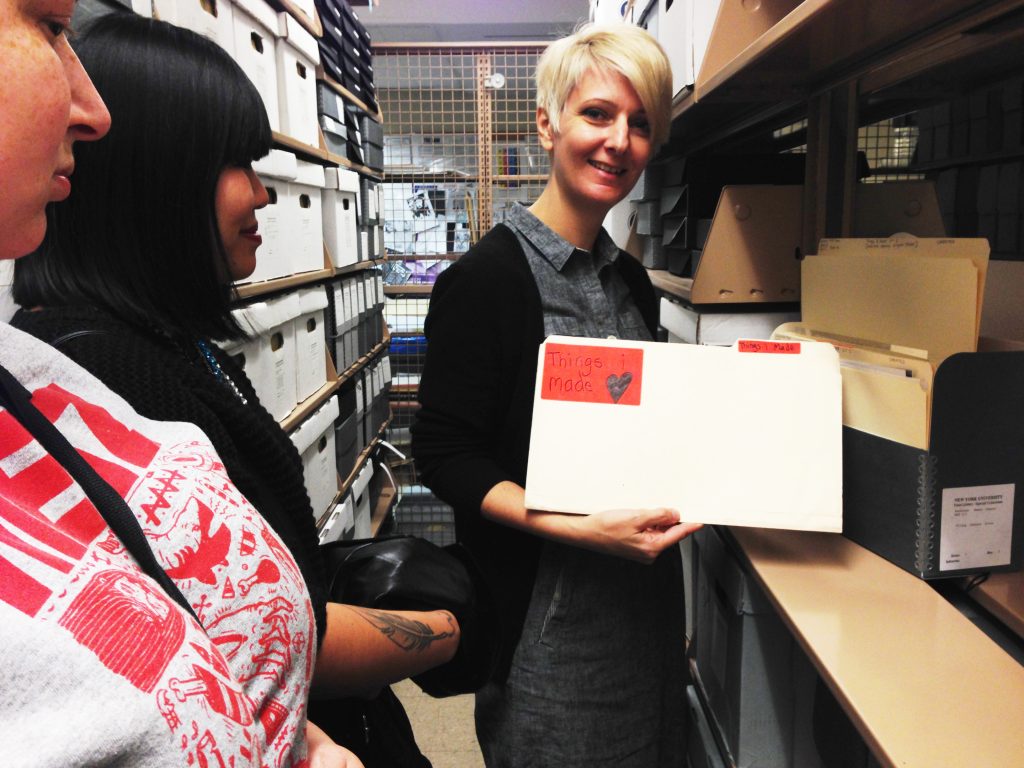 My first stop was the Fales Library at NYU. My zine partners and I were lucky to score a tour of The Riot Grrrl Collection by Lisa Darms, the ex-pat Canadian librarian who put together this year’s awesome book of the same name. The collection is open to the public by appointment only, and Darms was willing to show us eager zinesters around. If you ever research Riot Grrrl culture for a project, and can go to NYC, be sure to ask to take a look at this collection.
My first stop was the Fales Library at NYU. My zine partners and I were lucky to score a tour of The Riot Grrrl Collection by Lisa Darms, the ex-pat Canadian librarian who put together this year’s awesome book of the same name. The collection is open to the public by appointment only, and Darms was willing to show us eager zinesters around. If you ever research Riot Grrrl culture for a project, and can go to NYC, be sure to ask to take a look at this collection.
Darms took us to a back room that holds treasures of Riot Grrrl’s past, including some of Kathleen Hanna’s collection. There was a copy of the Bikini Kill zine, zines by Le Tigre’s Johanna Fateman, Hanna’s My Life with Evan Dando, Riot Grrrl manifesto newsletters, riot grrrl press and so much more. There were even the original file folders that Hanna had created to hold her collection, including one that had stickers on it with “Things I made <3.” There was even the dress from the cover of Bikini Kill’s album Pussy Whipped!
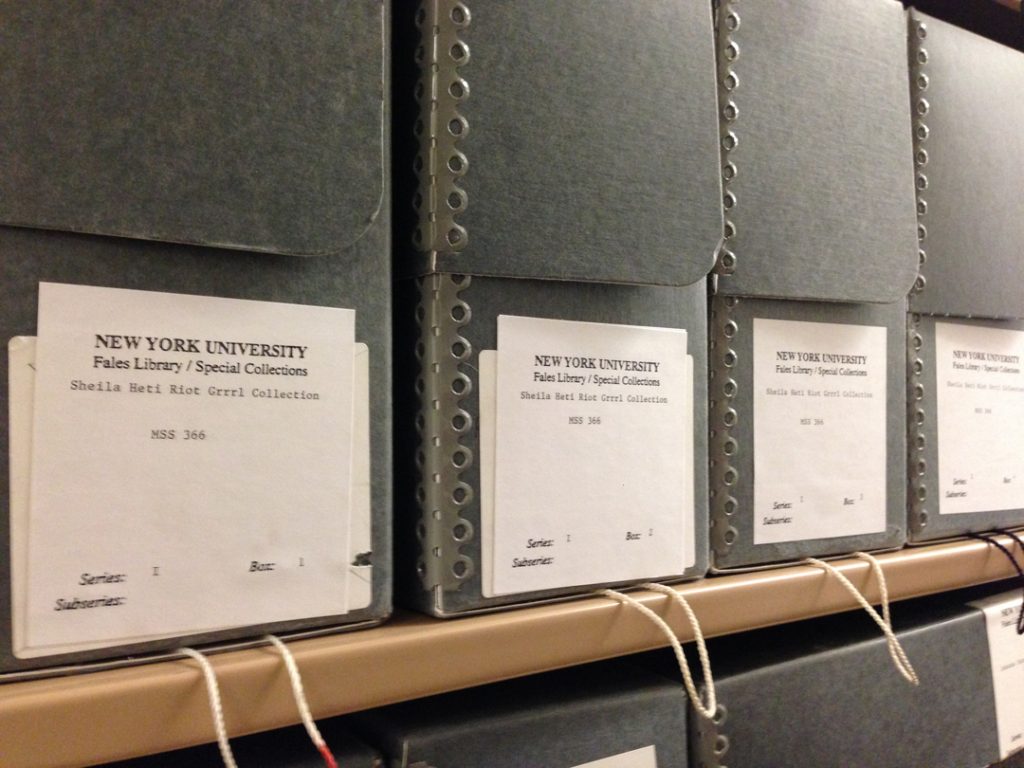 I was also fascinated by a collection from Toronto writer Sheila Heti. She created it in the mid-’90s when working on an anthology of writing by young women. But the book was turned down by Random House, who were the ones to suggest she do it in the first place. I contacted Heti to ask about trying to publish the collection again. “It never occurred to me to,” she said. “And I think the logistical problems might be huge – contacting and finding people (some of whom would have changed their name because of marriage) and then how many would want their raw 15-year-old writings published? But if you want to try, be my guest!” So, who wants to work on this book with me?
I was also fascinated by a collection from Toronto writer Sheila Heti. She created it in the mid-’90s when working on an anthology of writing by young women. But the book was turned down by Random House, who were the ones to suggest she do it in the first place. I contacted Heti to ask about trying to publish the collection again. “It never occurred to me to,” she said. “And I think the logistical problems might be huge – contacting and finding people (some of whom would have changed their name because of marriage) and then how many would want their raw 15-year-old writings published? But if you want to try, be my guest!” So, who wants to work on this book with me?
“One of my favourite aspects of the collection is how the different archives interact with each other, and how they serve as evidence of various networks of friendship and communication,” Darms told me in an email. “For example, Ramdasha Bikceem donated her zine Gunk that she wrote as a teenager in the ’90s, as well as her collection of other people’s zines and letters. So we find a letter from Riot Grrrl instigator Tobi Vail in her collection, but we also find letters from Ramdasha in Sheila Heti’s Archive. Similarly, the Kathleen Hanna Newsletter zine we have is addressed to Johanna Fateman in New York… Kathleen later moves to New York and forms Le Tigre with Johanna. And of course the zines themselves respond to and react to each other. It goes on and on.”
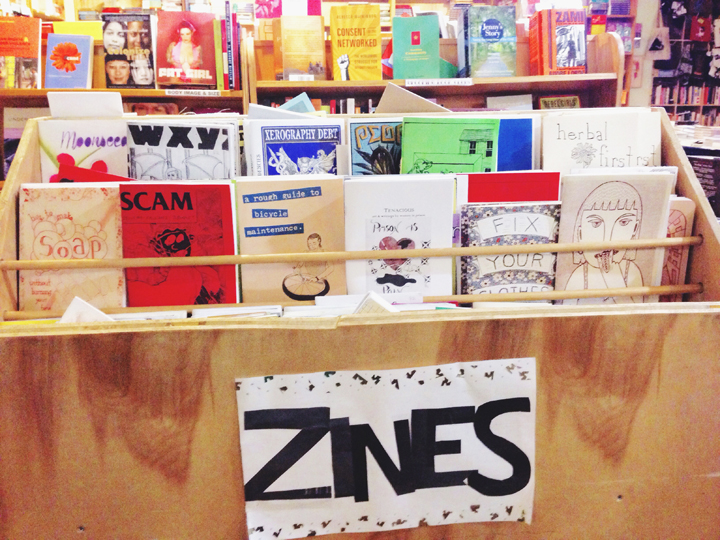 My second stop was Bluestockings, a feminist bookstore. It made me mourn the Toronto Women’s Bookstore, which was quite similar. Bluestockings has a small café, which seemed to be in high demand on a Saturday evening. The store’s full of activist and feminist titles. There was one shelving unit that was full of zines. I didn’t have much time to go through it all, but I did leave with a copy of the new issue of The Worst, which I was excited to bring back to the Toronto Zine Library. Bluestockings also sells a bunch of books related to zines, such as a Doris anthology and Notes from the Underground: Zines and the Politics of Alternative Culture. Somehow, after the 15 minutes I was in the store, I left with a huge stack of books to meet my friends who shook their heads at me and my future back problems.
My second stop was Bluestockings, a feminist bookstore. It made me mourn the Toronto Women’s Bookstore, which was quite similar. Bluestockings has a small café, which seemed to be in high demand on a Saturday evening. The store’s full of activist and feminist titles. There was one shelving unit that was full of zines. I didn’t have much time to go through it all, but I did leave with a copy of the new issue of The Worst, which I was excited to bring back to the Toronto Zine Library. Bluestockings also sells a bunch of books related to zines, such as a Doris anthology and Notes from the Underground: Zines and the Politics of Alternative Culture. Somehow, after the 15 minutes I was in the store, I left with a huge stack of books to meet my friends who shook their heads at me and my future back problems.
My last stop was the Barnard Zine Library, which is at Barnard College. My friend and I found it after many confused looks from security guards in response to the word “zine.” Barnard’s collection is focused on feminist zines, including activist, Riot Grrrrl, body image, gender, queer, people of colour and more.
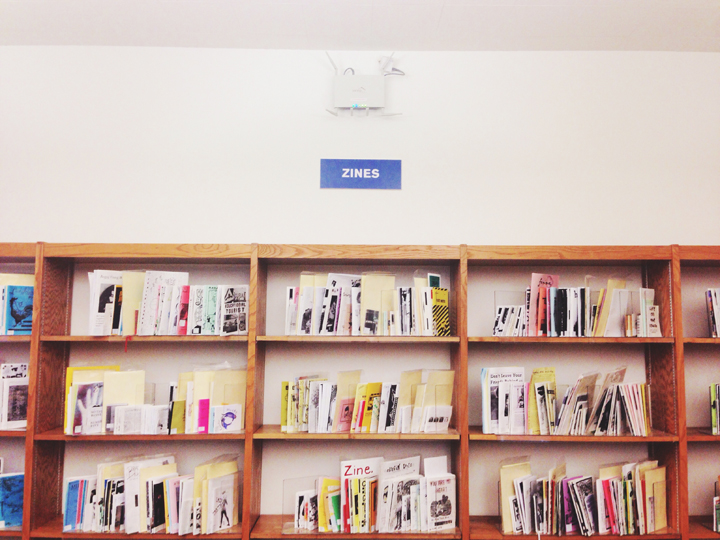 “I think it’s essential for libraries to collect, preserve and provide access to materials not or underrepresented in mainstream publications,” said librarian Jenna Freedman in an email. “Many, if not most, provide information and points of view from people less present in the texts and other than journalists and historians who report and interpret our world. I don’t think it would be hard to determine that zine authors differ from other authors in academic and public library collections in that they’re, as a group, younger, less educated, make less money, have more radical points of view, and have an outrageously higher percentage of women and queer publishers. (I’m less certain about the proportional representation of POC authors in zines vs. mainstream publications.) I think it’s incredibly empowering to walk into a space where female and queer are the default, and where the word “cisgender” is in wide use.”
“I think it’s essential for libraries to collect, preserve and provide access to materials not or underrepresented in mainstream publications,” said librarian Jenna Freedman in an email. “Many, if not most, provide information and points of view from people less present in the texts and other than journalists and historians who report and interpret our world. I don’t think it would be hard to determine that zine authors differ from other authors in academic and public library collections in that they’re, as a group, younger, less educated, make less money, have more radical points of view, and have an outrageously higher percentage of women and queer publishers. (I’m less certain about the proportional representation of POC authors in zines vs. mainstream publications.) I think it’s incredibly empowering to walk into a space where female and queer are the default, and where the word “cisgender” is in wide use.”
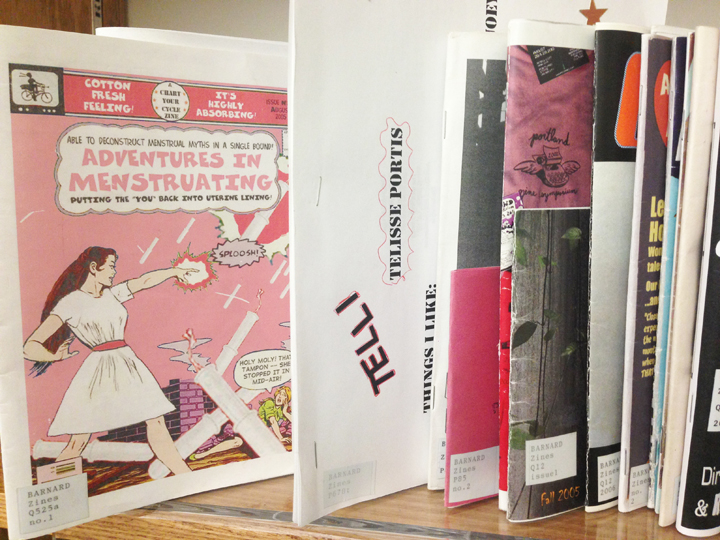 The library is displayed as a beautifully organized wall at the end of a computer lab. With only about 20 minutes to look around before the library closed, I saw some great-looking zines that I would have loved to sit and read for hours. The library also has an archives collection, in the same type of acid-free boxes NYU has, but we didn’t get to see those. The Barnard Library gets bonus points for having a photocopier a few steps away under huge posters about making zines and a gender-neutral bathroom.
The library is displayed as a beautifully organized wall at the end of a computer lab. With only about 20 minutes to look around before the library closed, I saw some great-looking zines that I would have loved to sit and read for hours. The library also has an archives collection, in the same type of acid-free boxes NYU has, but we didn’t get to see those. The Barnard Library gets bonus points for having a photocopier a few steps away under huge posters about making zines and a gender-neutral bathroom.
Next time I go to NYC, I want to check out the Mellow Pages Library, the ABC No Rio Zine Library and the New York Public Library’s zine collection. I’d also love to meet zinesters in any city I go to, or go to a launch or reading. Zines are everywhere!
Do you check out zines when you travel? Do you have any other New York City recommendations?




Zines, although they’re called ephemera in library lingo, are actually a lot more permanent than blogs. The zine reader gets to keep the thing forever. When the reader returns to the zine, unless zhe has spilled coffee on it or wrought some other type of damage, it will be the same. It may disappear due to the holder’s negligence, but not because the zinester couldn’t maintain hir domain name or website or could have, but got sick of doing so. A factor so significant in defining the difference between zines and blogs that it’s shocking this issue is so far down in this piece is that zines are finished products (even if serials catalogers don’t think so). Blogs are not. No matter how sloppy a zine is—and they really can be a mess—someone has taken responsibility for the thing as a whole. Blogs are in danger of only being as strong as their most recent post. The pressure is to add to it daily. Zinesters also put pressure on themselves to produce more regularly, but ultimately it doesn’t matter much. I am sad when my friend Celia [13] doesn’t send out a new zine for a year, but that doesn’t make me any less likely to read the new one when it finally comes. In fact, the delay adds to the thrill. If the blogger doesn’t post for a couple of weeks, zhe may lose hir readership altogether.
Self-published and micro-published works are vital to the library community. They exhibit subject matter often overlooked by larger publishing companies, and provide a platform for local authors to present their works. We are gathering local materials for our catalog including: small-press-issued graphic novels and poetry, self-published cookbooks, zines, memoirs, niche non-fiction, local history, and university press research and literature. It is our goal to use this historic neighborhood venue to showcase the works of local authors and artists.